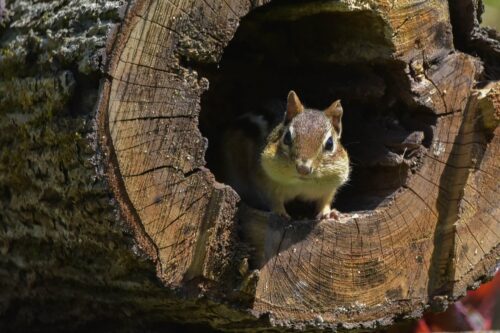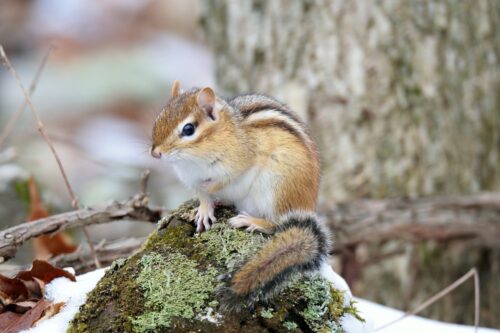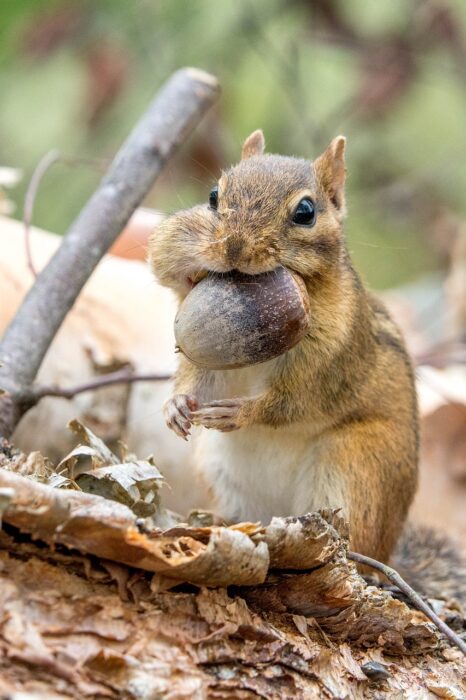Chicken Little Chipmunks

Checking to see if the coast is clear
The predators come in all shapes and sizes. They fly, they run, and they slither. They drop from the sky, they creep from behind rotting stumps, they rise from the leaf litter. If you’re an eastern chipmunk, you’ve got a lot to fear. Foxes, hawks, bobcats, coyotes, owls, fishers, weasels, snakes, racoons, and more, including domestic cats and dogs, are after you.
But you’ve got to eat, and that means leaving the shelter of your burrow or hollow log. You eat what you can forage: maple seeds, beech nuts, seedlings, acorns, trout lily tubers, fungi, fruit, berries, and even flowers. And you do some hunting of your own for slugs, worms, insects, snakes, frogs, mice, and birds’ eggs. Somehow, some way, you’ve got to eat without being eaten. You’re always balancing risk and safety—searching for more beech nuts while avoiding the talons of a hawk. As Woody Allen is reputed to have said, Nature: one big restaurant.
In the fall, the stakes get higher as chipmunks gather food for the winter. Naturalists use words like frenetic,frenzied, intense, and obsessive to describe their work. Unlike bears or woodchucks, chipmunks don’t fatten up for winter; instead, they cache seeds and nuts in special chambers in their burrows. They hibernate, but only enter torpor for a couple of weeks at a time and then wake up to eat before sleeping again. They may emerge aboveground on mild winter days, but their below-ground hoard must get them through.

Their cheek pouches make them champion gatherers. In Naturally Curious, Mary Holland describes a study in which a single chipmunk was observed carrying 116 acorns, roughly six at a time, across 200 feet to its burrow. All in one hour. That’s a lot for an animal that weighs five ounces (or less) and measures six to seven inches long (minus its tail). A chipmunk may gather and eat up to half a bushel—over four and a half gallons—over the winter.
How do they manage to stock their larders and avoid predators? Though chipmunks are solitary and territorial, they warn one another of danger with chips, chucks, and trills. When one chipmunk sounds the alarm, and others join in, they can swiftly spread a warning.
It’s not surprising that chipmunks signal danger. Lots of animals do. Different species may even join forces in a “defensive alliance,” as Rivka Galchen calls it in a recent article in The New Yorker about bird communication. Early one morning in the woods, I heard a commotion and looked up. Songbirds—a few chickadees, a sparrow, a titmouse, a cardinal—had gathered near a barred owl, and each bird in its own fashion was yelling “Owl, owl, owl!” Certainly, they’d alerted all the birds in the vicinity (and me) that it was there. The owl, which had settled on a branch, looked miserable and bothered—though I’m probably projecting.
Animals have a lot to say. Researchers increasingly recognize that animals’ calls are more nuanced and convey more detailed information than we have recognized. Of course, the animals have been making the same sounds all along; we’ve just been slow on the uptake. Greylag geese honk, but that honk comprises ten different calls. Vervet monkeys warn one another what kind of predator is approaching, and the other monkeys take distinct evasive action based on the information. The same is true of chipmunks: their calls vary according to the type and severity of danger. Is it a hawk or a coyote? Close by?
But there’s a twist: Not all chipmunk alarm calls are made alike.
Behavioral ecologist Charline Couchoux led a study of chipmunks in the forests just north of the Vermont-Québec border. She and her colleagues found that some chipmunks are far more easily spooked than others. Like Chicken Little, these chipmunks sound the alarm at the first distant drop of an acorn or snap of a twig and scurry for cover. Some chipmunks, like some people, are highly vigilant, take fewer risks, and are easily startled. We might call them catastrophists, though ecologists use more neutral language and call them shy. Other chipmunks are bold. They’re less vigilant, take more risks, and are slower to signal danger. The researchers took other factors into account and determined that shyness and boldness are essentially personality traits. Not so surprising: All of our nervous systems are wired differently. I’m an optimistic-fatalist married to a catastrophist.

Couchoux recorded the calls of a range of chipmunks—the shy, the bold, and those between—and played them for other chipmunks as they were foraging. Here’s the twist: the chipmunks responded differently to the alarm calls depending on whether the caller was shy or bold. They knew a Chicken Little when they heard one, and kept on searching for food (though shy chipmunks were more likely to pay attention). They had work to do, and false alarms wasted energy and time.
When a bold chipmunk signaled danger, however, all the chipmunks took notice. It didn’t matter whether the other chipmunks were familiar with the individual caller or not; they could decode and interpret the vocalization itself and determine whether the information was likely to be reliable or unreliable. They could hear the difference between the alarm call of a chipmunk who treated every startling shadow or sound as if it were a hawk or coyote and the call of a chipmunk who only yelled “hawk” when there was an actual hawk. Luckily, my catastrophist at home has a more expansive vocabulary, so she doesn’t call a snapping twig a coyote, even if her “Oh, no!” sometimes makes it sound like there’s a coyote in the house when she can’t find the grocery list.
References (in the order of their first appearance):
“Mammals of the Adirondacks: Eastern Chipmunk (Tamias striatus).” Adirondacks Forever Wild. wildadirondacks.org.
Mary Holland. Naturally Curious. Trafalgar Square Books, 2019.Rivka Galchen. “Pecking Order.” The New Yorker (October 21. 2024).
Zoë Schlanger. The Light Eaters: How the Unseen World of Plant Intelligence Offers a New Understanding of Life on Earth. Harper Collins, 2024.
Surprisingly, I found a description of Charline Couchoux’s chipmunk study in this book–an account of recent studies of plant intelligence, a highly controversial idea–in a chapter about ways that plants emit chemical signals (alarm calls!) when they are under attack.
Charline Couchoux, Jeanne Clermont, Dany Garant, and Denis Réale. “Signaler and Receiver Boldness Influence Response to Alarm Calls in Eastern Chipmunks.” Behavioral Ecology 29:1 (January/February 2018).
